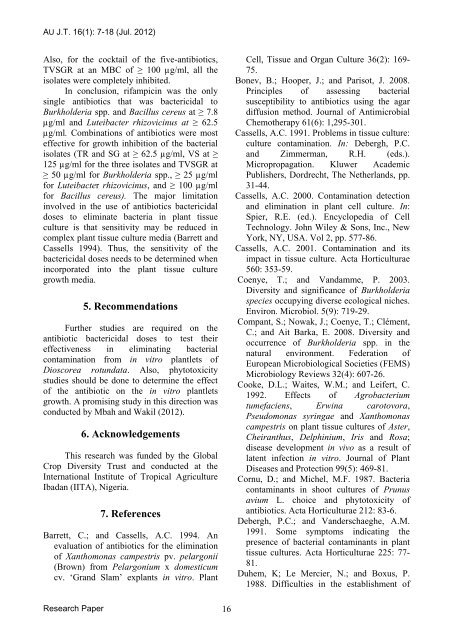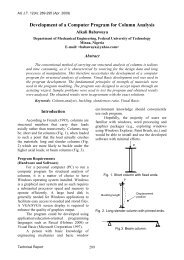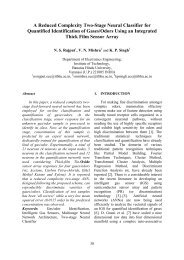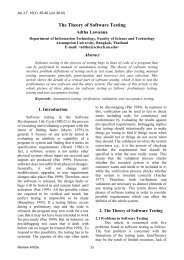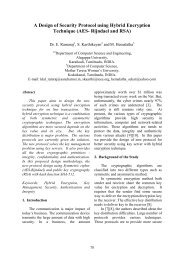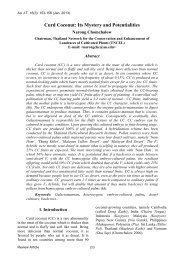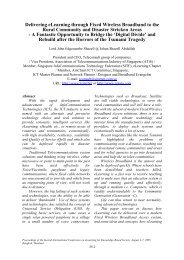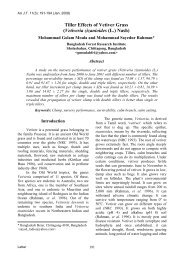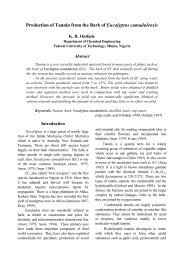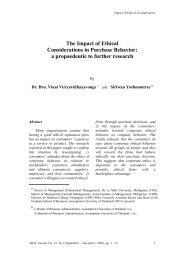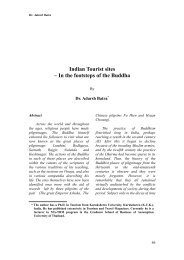Screening Antibiotics for the Elimination of Bacteria ... - AU Journal
Screening Antibiotics for the Elimination of Bacteria ... - AU Journal
Screening Antibiotics for the Elimination of Bacteria ... - AU Journal
You also want an ePaper? Increase the reach of your titles
YUMPU automatically turns print PDFs into web optimized ePapers that Google loves.
<strong>AU</strong> J.T. 16(1): 7-18 (Jul. 2012)<br />
Also, <strong>for</strong> <strong>the</strong> cocktail <strong>of</strong> <strong>the</strong> five-antibiotics,<br />
TVSGR at an MBC <strong>of</strong> ≥ 100 µg/ml, all <strong>the</strong><br />
isolates were completely inhibited.<br />
In conclusion, rifampicin was <strong>the</strong> only<br />
single antibiotics that was bactericidal to<br />
Burkholderia spp. and Bacillus cereus at ≥ 7.8<br />
µg/ml and Luteibacter rhizovicinus at ≥ 62.5<br />
µg/ml. Combinations <strong>of</strong> antibiotics were most<br />
effective <strong>for</strong> growth inhibition <strong>of</strong> <strong>the</strong> bacterial<br />
isolates (TR and SG at ≥ 62.5 µg/ml, VS at ≥<br />
125 µg/ml <strong>for</strong> <strong>the</strong> three isolates and TVSGR at<br />
≥ 50 µg/ml <strong>for</strong> Burkholderia spp., ≥ 25 µg/ml<br />
<strong>for</strong> Luteibacter rhizovicinus, and ≥ 100 µg/ml<br />
<strong>for</strong> Bacillus cereus). The major limitation<br />
involved in <strong>the</strong> use <strong>of</strong> antibiotics bactericidal<br />
doses to eliminate bacteria in plant tissue<br />
culture is that sensitivity may be reduced in<br />
complex plant tissue culture media (Barrett and<br />
Cassells 1994). Thus, <strong>the</strong> sensitivity <strong>of</strong> <strong>the</strong><br />
bactericidal doses needs to be determined when<br />
incorporated into <strong>the</strong> plant tissue culture<br />
growth media.<br />
5. Recommendations<br />
Fur<strong>the</strong>r studies are required on <strong>the</strong><br />
antibiotic bactericidal doses to test <strong>the</strong>ir<br />
effectiveness in eliminating bacterial<br />
contamination from in vitro plantlets <strong>of</strong><br />
Dioscorea rotundata. Also, phytotoxicity<br />
studies should be done to determine <strong>the</strong> effect<br />
<strong>of</strong> <strong>the</strong> antibiotic on <strong>the</strong> in vitro plantlets<br />
growth. A promising study in this direction was<br />
conducted by Mbah and Wakil (2012).<br />
6. Acknowledgements<br />
This research was funded by <strong>the</strong> Global<br />
Crop Diversity Trust and conducted at <strong>the</strong><br />
International Institute <strong>of</strong> Tropical Agriculture<br />
Ibadan (IITA), Nigeria.<br />
7. References<br />
Barrett, C.; and Cassells, A.C. 1994. An<br />
evaluation <strong>of</strong> antibiotics <strong>for</strong> <strong>the</strong> elimination<br />
<strong>of</strong> Xanthomonas campestris pv. pelargonii<br />
(Brown) from Pelargonium x domesticum<br />
cv. ‘Grand Slam’ explants in vitro. Plant<br />
Cell, Tissue and Organ Culture 36(2): 169-<br />
75.<br />
Bonev, B.; Hooper, J.; and Parisot, J. 2008.<br />
Principles <strong>of</strong> assessing bacterial<br />
susceptibility to antibiotics using <strong>the</strong> agar<br />
diffusion method. <strong>Journal</strong> <strong>of</strong> Antimicrobial<br />
Chemo<strong>the</strong>rapy 61(6): 1,295-301.<br />
Cassells, A.C. 1991. Problems in tissue culture:<br />
culture contamination. In: Debergh, P.C.<br />
and Zimmerman, R.H. (eds.).<br />
Micropropagation. Kluwer Academic<br />
Publishers, Dordrecht, The Ne<strong>the</strong>rlands, pp.<br />
31-44.<br />
Cassells, A.C. 2000. Contamination detection<br />
and elimination in plant cell culture. In:<br />
Spier, R.E. (ed.). Encyclopedia <strong>of</strong> Cell<br />
Technology. John Wiley & Sons, Inc., New<br />
York, NY, USA. Vol 2, pp. 577-86.<br />
Cassells, A.C. 2001. Contamination and its<br />
impact in tissue culture. Acta Horticulturae<br />
560: 353-59.<br />
Coenye, T.; and Vandamme, P. 2003.<br />
Diversity and significance <strong>of</strong> Burkholderia<br />
species occupying diverse ecological niches.<br />
Environ. Microbiol. 5(9): 719-29.<br />
Compant, S.; Nowak, J.; Coenye, T.; Clément,<br />
C.; and Ait Barka, E. 2008. Diversity and<br />
occurrence <strong>of</strong> Burkholderia spp. in <strong>the</strong><br />
natural environment. Federation <strong>of</strong><br />
European Microbiological Societies (FEMS)<br />
Microbiology Reviews 32(4): 607-26.<br />
Cooke, D.L.; Waites, W.M.; and Leifert, C.<br />
1992. Effects <strong>of</strong> Agrobacterium<br />
tumefaciens, Erwina carotovora,<br />
Pseudomonas syringae and Xanthomonas<br />
campestris on plant tissue cultures <strong>of</strong> Aster,<br />
Cheiranthus, Delphinium, Iris and Rosa;<br />
disease development in vivo as a result <strong>of</strong><br />
latent infection in vitro. <strong>Journal</strong> <strong>of</strong> Plant<br />
Diseases and Protection 99(5): 469-81.<br />
Cornu, D.; and Michel, M.F. 1987. <strong>Bacteria</strong><br />
contaminants in shoot cultures <strong>of</strong> Prunus<br />
avium L. choice and phytotoxicity <strong>of</strong><br />
antibiotics. Acta Horticulturae 212: 83-6.<br />
Debergh, P.C.; and Vanderschaeghe, A.M.<br />
1991. Some symptoms indicating <strong>the</strong><br />
presence <strong>of</strong> bacterial contaminants in plant<br />
tissue cultures. Acta Horticulturae 225: 77-<br />
81.<br />
Duhem, K; Le Mercier, N.; and Boxus, P.<br />
1988. Difficulties in <strong>the</strong> establishment <strong>of</strong><br />
Research Paper 16


